Chances are you have just read about what a backlink analysis is, and now want to know how to do it. Maybe you already know what a backlink analysis is and are looking for an example to get some inspiration.
Either way you have come to the right place, as I will guide you through a backlink analysis.
How do I find backlinks to my site?
To find who links to your site, you will need to use an SEO tool. An SEO tool will make this process efficient and fast.
There are plenty of SEO tools to choose from. Ahrefs, SEMRush, Moz, and our own Morningscore, that are mentioned as one of the best link building software in 2025, all have features that will help you start a backlink analysis and continue tracking just the important factors from there on.
The price range can vary greatly between them and which one is best for you depends on the amount of time you plan to use on SEO, and which features you are interested in.
Most of these tools have their own way of measuring a website’s link profile. Ahrefs uses DR, Moz uses DA and Morningscore has Linkscore. Picking one comes down to preference. What is important here is to avoid comparing links using different metrics. Pick one and stick to it when determining link authority.
We will be using Morningscore for the following example.
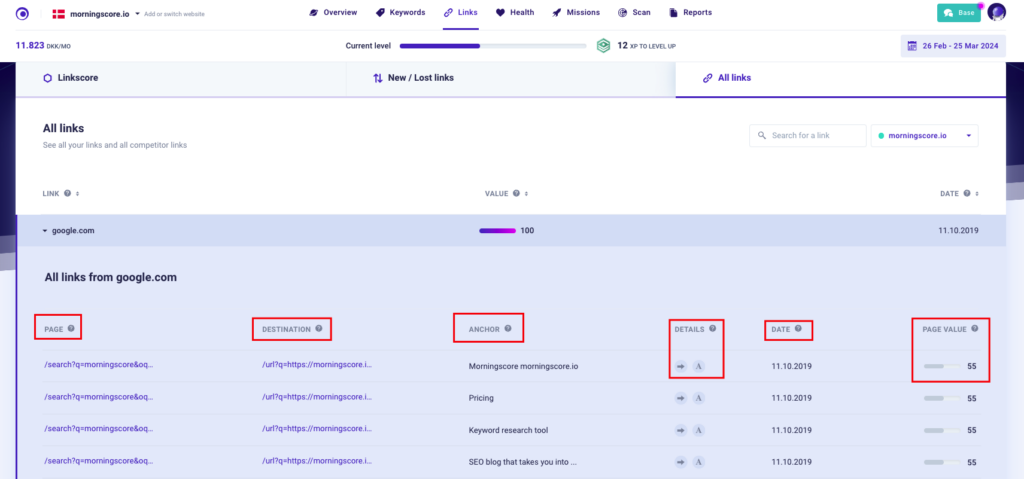
In Morningscore’s link tool, scroll down to “All links”. Here you will be able to see all of your inbound links and their metrics.
Among these metrics are:
- the URL of the exact webpage where your backlink is placed
- its anchor text
- the date when it was discovered
- destination URL
- whether the link is dofollow or nofollow
- and the value of the link.
You are able to search for a specific domain, sort by the metrics or export all the data.
(If you don’t already have a Morningscore account, grab your 14-day free trial. You’ll thank me later. 👍)
Understanding the Morningscore link metrics
Morningscore uses its own unique metrics to compare websites and link value in its link tool.
These are Linkscore (which is a similar metric to Ahrefs’ DR and Moz’ DA) and link popularity.
What is linkscore and how does it work?
The first thing you will notice in a link report is your Linkscore. Linkscore is your number one indicator of link building efficiency.This is the global position of your website compared to every other website on the internet. It is determined by the number and value of your backlinks.
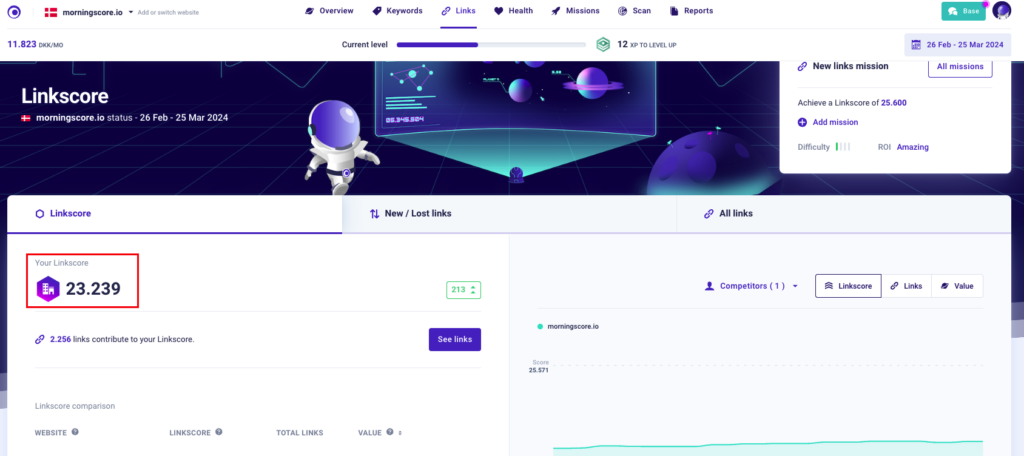
Keeping an eye on your Linkscore history is an easy way of checking up on your link building progress.
By using the calendar, you can check everyday changes. Always remember to include a couple of extra days or weeks (depending on the Linkscore of the websites that link to you) after the last link building activity. It takes time for the spiders to discover those links and apply the link equity to your website.
What is link popularity?
Right below your Linkscore, you can see your link popularity. Link popularity is just a fancy word for all the links contributing to your Linkscore. By scrolling down to “All links” you get an overview of all the domains that link to you and their value (or domain authority). The higher their value, the higher the amount of link equity they will pass on to you. Keep an eye on the value of your links to figure out which links give you the most equity, so you know which type of links to spend your time on in your future link building activities.
Populating the all links list with as many high-value domains is your number one goal. Your next two are keeping the good links and removing the bad ones.
How to get an overview of my backlink activity?
Using Morningscore’s Link tool you can get a clear overview of all the new backlinks and all the lost one for a given period of time.
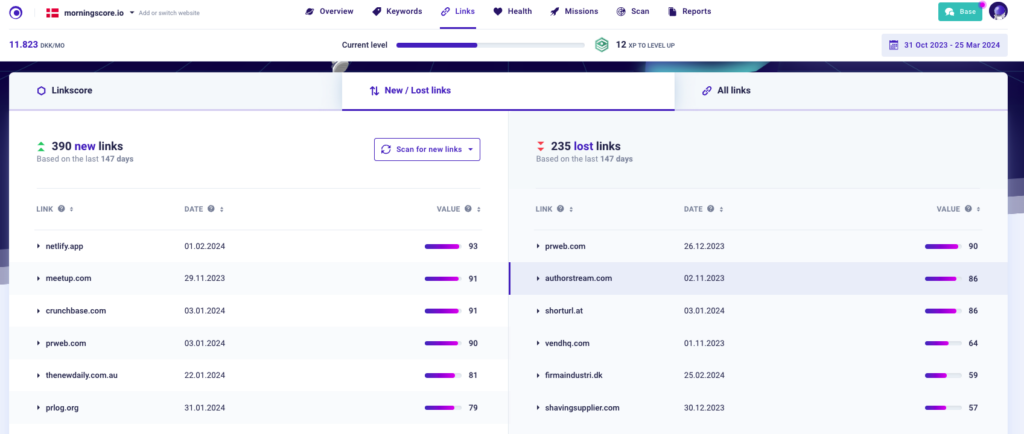
Keeping an eye on this section will help you identify new links from non-desirable sites (bad links) fast. You will also be notified as soon as one of your link building activity is successful or when you lost a link. Loosing links is normal, but it is important to check each lost link in case it was removed by mistake and start the reclamation process.
How to do a backlink analysis (quick, simple & effective)?
To analyze your backlink profile, you will need a SEO tool. Feel free to use whatever you prefer, but we will continue using Morningscore in our examples.
In Morningscore, click on the “Links” tab at the top of the page.
What we will focus mostly on here is to check how natural your link profile is and what you should focus on in the future.
Check your linkscore
Linkscore is used to compare your website to all the other websites in the whole world. It is calculated based on the number of strong links pointing to your website. The higher it is, the easier it will be for you to rank.
Whether your Linkscore is good or bad depends on the size of your company and your industry.
A good rule of thumb is that a small to medium sized company usually ranks from 500 – 5000, where 5000+ would be a really good Linkscore.
Also, check if there is a positive or a negative change since you started with your link building activities.
Are you still unsure what a good rank for your company is?
Then add a few competitors and compare how they are doing with their link building. The best competitor to compare yourself to is the one that is consistently beating you on Google for several keywords.
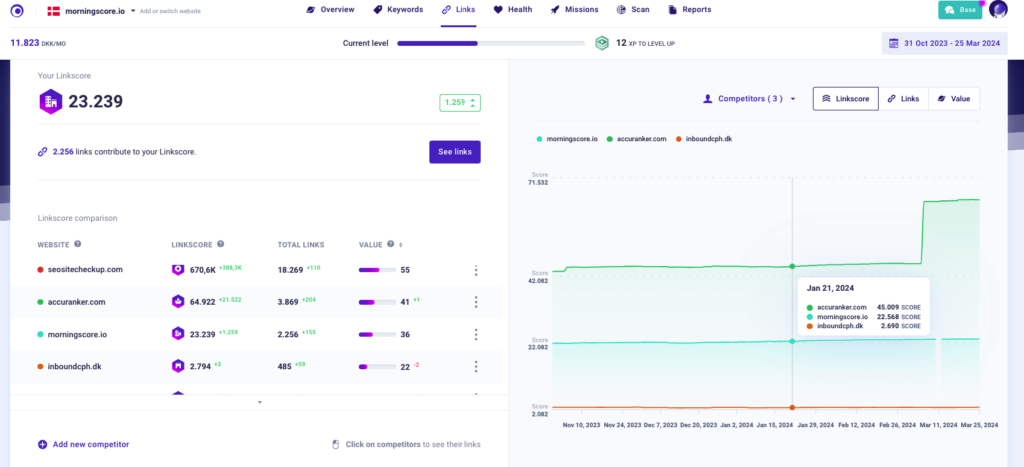
Check your anchor texts
Using only anchor texts that are an exact match to your keyword can create a whole load of problems.
Imagine if you didn’t put any effort into link building and just sat and waited for links to come in naturally (this is what Google expects of you anyway).
Now, how many do you imagine would have the same anchor text, with just one keyword or keyword phrases, linking to the same webpage. Not many, I can tell you.
So, we need to focus a bit on the anchor text ratio.
Most of your links should use an anchor text that is either the brand name, the URL it links to or a generic word like “here”, “Read more”, “this link”. I am talking about at least 80% (some say up to 95%).
The rest should be distributed between anchor texts that are an exact match (just the keyword) and broad match phrases (a phrase that includes the keyword). With these last two types, always remember – less is more.
There are two scenarios when it comes to the anchor text ratio:
- You are just starting off with link building and don’t have many backlinks
If you only have a couple of backlinks, it will be easy to quickly check their anchor text in Morningscore.
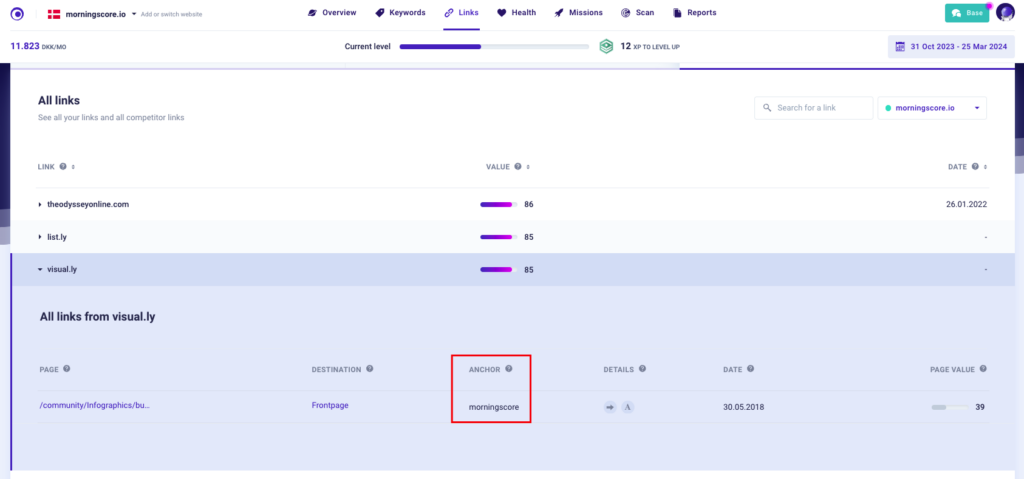
Just scroll down to “All links” in the Link tool and click through all the links. Only the keyword anchor texts are important here. Write down any exact or broad match keyword you find and the page on your domain it is linking to. This should give you a general idea of how high of a percentage matches your keywords when compared to the total number of your backlinks.
- Your website already has many backlinks and you don’t have in-depth data for them
In this case, you will need an in-depth link tool to help you out.
I would recommend Ahrefs in this case. For this task alone it will be enough to pay for the 7-day trial. That will also give you a chance to test the tool further and decide if it is something you will need on a regular basis.
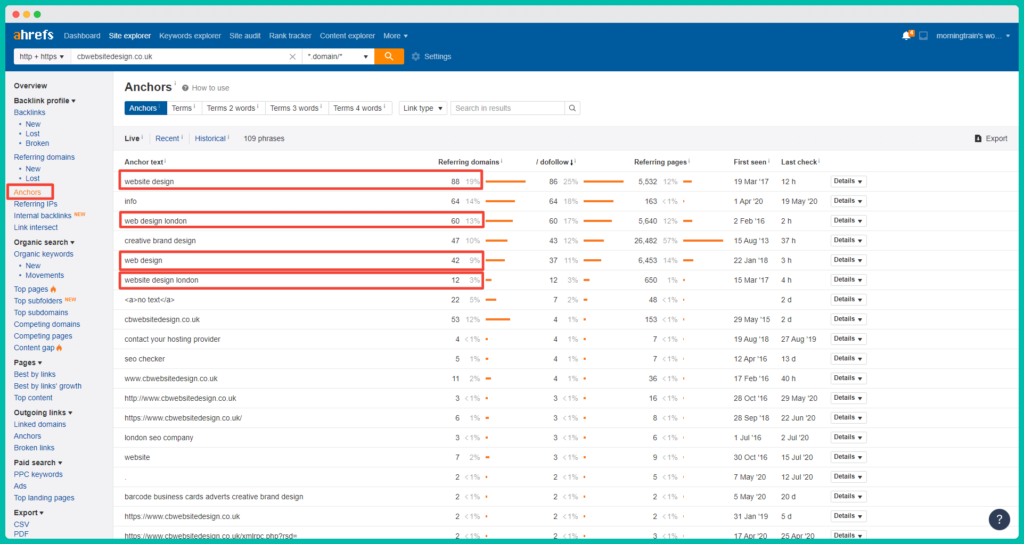 Distribution off backlinks across your website
Distribution off backlinks across your website
Every time you optimize a page you should also build a couple of backlinks for it, and a couple of internal links from the new page to the old ones (and vice versa) to spread the link equity.
Having backlinks only to your homepage is not a sign of a natural link profile. It is also a good way to create a link equity bottleneck as you will not be able to give your other webpages a proper boost in ranking.
Final words
I hope this article gave you some of what you needed in terms of a backlink analysis. If you want to further expand your knowledge about backlinks, you should read this. If you want to know the difference between good and bad link, this might also be a good read.
FAQ
How to effectively manage and prioritize backlinks for removal or disavowal?
Prioritize backlinks for removal or disavowal based on their spam score, relevance to your niche, and the quality of the linking domain. Use tools like Google’s Disavow Tool cautiously to disavow backlinks only when direct removal requests to the linking site’s webmasters fail.
Can the effectiveness of a backlink from a specific domain change over time, and how should one monitor and adapt to these changes?
The value of a backlink can indeed change as domains gain or lose authority and relevance. Regularly monitoring your backlink profile with SEO tools helps identify and adapt to these changes, ensuring your backlink strategy remains effective.
What are the specific risks associated with over-optimizing anchor text, and how can one recover from penalties related to it?
Over-optimized anchor text can lead to penalties from search engines, as it may appear manipulative. If penalized, diversify your anchor text distribution and focus on more natural, relevant linking practices. Review and adjust your backlinks’ anchor text to be more in line with your content’s context and user expectations.

